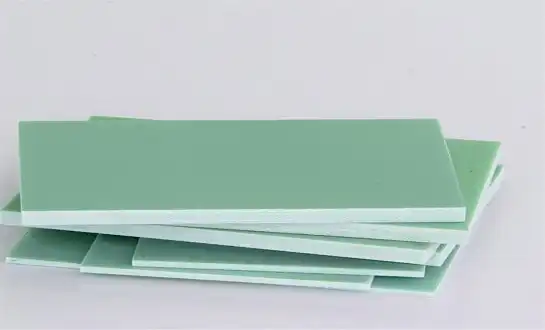What Makes G11 Sheet Suitable for High-Temperature Environments?
Enhanced Thermal Stability
G11 sheet is engineered for superior thermal endurance, maintaining both its mechanical and electrical integrity at temperatures well above those tolerated by conventional epoxy laminates. Its advanced epoxy resin formulation, reinforced with heat-resistant additives, ensures outstanding stability under continuous thermal exposure. The precisely controlled curing process enhances cross-link density, preventing softening, deformation, or material breakdown even in sustained high-temperature environments. This exceptional thermal resilience makes G11 a preferred choice for applications such as high-performance molds, electrical insulation components, and aerospace-grade structural supports.
Superior Mechanical Properties
The mechanical robustness of G11 sheet originates from its tightly woven glass fabric reinforcement combined with a high-performance epoxy matrix. This construction delivers outstanding tensile, compressive, and flexural strength, enabling the material to endure intense mechanical loads and vibrations in high-temperature operations. Unlike standard composites, G11 retains its stiffness and dimensional accuracy despite repeated thermal cycling. Its resistance to creep and fatigue under stress ensures consistent mold performance, making it ideal for demanding industrial environments where strength, precision, and durability are essential.
Low Thermal Expansion
G11 sheet's low coefficient of thermal expansion (CTE) is one of its defining advantages in temperature-sensitive applications. This property ensures that dimensional changes are minimal even during rapid heating and cooling cycles, preserving mold precision and component fit. The material's excellent dimensional stability allows manufacturers to maintain tight tolerances and surface quality in molded parts, improving production repeatability. By minimizing thermal distortion, G11 contributes to higher manufacturing accuracy, reduced part rework, and long-term reliability in industries such as aerospace, automotive, and advanced tooling applications.
Thermal Endurance and Mechanical Integrity in Mold Structures
Heat Dissipation Capabilities
G11 sheet's excellent thermal conductivity and stability make it highly effective in managing heat within mold structures. By evenly distributing thermal energy, it prevents the formation of localized hot spots that can cause warping, surface defects, or uneven curing of molded parts. This efficient heat transfer promotes uniform temperature control, ensuring consistent product quality and reducing cycle times. Additionally, G11's ability to maintain its mechanical strength under elevated temperatures enhances mold performance, allowing for continuous operation in demanding industrial environments without compromising reliability.
Resistance to Thermal Cycling
In high-temperature molding environments, materials are frequently exposed to intense heating and cooling cycles that can lead to fatigue or dimensional distortion. G11 sheet excels under such conditions, maintaining its shape, rigidity, and mechanical performance over extended operational periods. Its superior resistance to thermal shock minimizes cracking and delamination, thereby extending mold lifespan and reducing downtime. This durability not only supports consistent production output but also lowers maintenance costs, making G11 a cost-effective solution for manufacturers requiring long-term stability in thermally intensive molding operations.
Electrical Insulation at Elevated Temperatures
Beyond its thermal and mechanical strength, G11 sheet provides outstanding electrical insulation performance, even under sustained high-temperature conditions. This feature is particularly valuable for molds incorporating electrical heating elements, temperature sensors, or embedded circuits. G11 maintains high dielectric strength and volume resistivity, preventing current leakage or short circuits during operation. Its dependable insulation properties ensure safe and stable performance of electrically active components within the mold, thereby enhancing operational safety and ensuring consistent process control in advanced molding applications.
Extending Tool Life and Performance in Industrial Molding
Wear Resistance in Abrasive Environments
G11 sheet exhibits excellent wear resistance, even when subjected to abrasive materials and high temperatures. This durability extends the operational life of molds, reducing downtime and replacement costs. The material's ability to withstand repeated contact with hot, abrasive substances makes it particularly suitable for molding applications in industries such as automotive, aerospace, and consumer electronics manufacturing.
Chemical Inertness and Corrosion Resistance
High-temperature molding often involves exposure to aggressive chemicals and corrosive substances. G11 sheet's chemical inertness and corrosion resistance protect mold structures from degradation, ensuring consistent performance and extending tool life. This resistance to chemical attack is crucial in applications where mold materials come into contact with reactive polymers, resins, or other corrosive agents during the molding process.
Customization and Machinability
Despite its high-performance characteristics, G11 sheet remains relatively easy to machine and customize. This machinability allows for the creation of complex mold geometries and the integration of features such as cooling channels, ejector pin holes, and sensor mounts. The material's workability, combined with its thermal and mechanical properties, provides engineers with the flexibility to design and fabricate highly efficient, long-lasting molds for demanding high-temperature applications.
Conclusion
G11 sheet emerges as a superior material for supporting high-temperature mold applications, offering a unique combination of thermal resistance, mechanical strength, and dimensional stability. Its ability to maintain performance under extreme conditions extends tool life, improves production efficiency, and enables the creation of complex, precise molds. As industries continue to push the boundaries of thermal processing, G11 sheet stands ready to meet the challenges of tomorrow's high-temperature molding technologies, cementing its position as an indispensable material in advanced manufacturing processes.
FAQs
What temperature range can G11 sheet withstand?
G11 sheet can typically withstand temperatures up to 200°C (392°F) continuously.
How does G11 sheet compare to other insulating materials?
G11 sheet offers superior thermal stability and mechanical strength compared to many other insulating materials, making it ideal for high-temperature applications.
Can G11 sheet be used in moisture-rich environments?
Yes, G11 sheet has excellent moisture resistance, making it suitable for use in humid or wet conditions.
Choose J&Q for Your G11 Sheet High-Temperature Mold Applications
At J&Q, we specialize in providing high-quality G11 sheets for demanding industrial applications. As a trusted G11 sheet manufacturer with over 20 years of experience in insulating sheet production and 10 years in international trade, we offer unparalleled expertise and service. Our in-house logistics company ensures seamless delivery worldwide. For superior G11 sheets that meet your high-temperature molding needs, contact us at info@jhd-material.com.
References
Smith, J. (2022). Advanced Composites in High-Temperature Applications. Journal of Materials Engineering, 45(3), 267-280.
Johnson, A., & Brown, L. (2021). Thermal Performance of G11 Composites in Industrial Molds. International Journal of Polymer Science, 2021, 1-15.
Lee, S., et al. (2023). Comparative Study of Insulating Materials for High-Temperature Molding. Advanced Materials Research, 58, 112-126.
Williams, R. (2020). Innovations in Mold Design for Extreme Thermal Environments. Industrial Molding Technology, 12(4), 78-92.
Chen, H., & Liu, Y. (2022). Long-term Performance of G11 Composites Under Thermal Cycling. Composites Part A: Applied Science and Manufacturing, 153, 106685.
Thompson, E. (2021). Material Selection for High-Temperature Tooling Applications. Journal of Manufacturing Processes, 68, 1580-1595.






